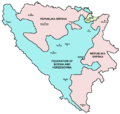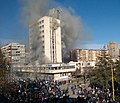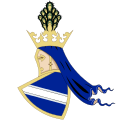Portal:Bosnia and Herzegovina
Welcome to the Bosnia and Herzegovina Portal
 |
 |

| |
Bosnia and Herzegovina, sometimes known as Bosnia-Herzegovina and informally as Bosnia, is a country in Southeast Europe. Situated on the Balkan Peninsula, it borders Serbia to the east, Montenegro to the southeast, and Croatia to the north and southwest, with a 20-kilometre-long (12-mile) coast on the Adriatic Sea in the south. Bosnia has a moderate continental climate with hot summers and cold, snowy winters. Its geography is largely mountainous, particularly in the central and eastern regions, which are dominated by the Dinaric Alps. Herzegovina, the smaller, southern region, has a Mediterranean climate and is mostly mountainous. Sarajevo is the capital and the largest city.
The area has been inhabited since at least the Upper Paleolithic, with permanent human settlement traced to the Neolithic cultures of Butmir, Kakanj, and Vučedol. After the arrival of the first Indo-Europeans, the area was populated by several Illyrian and Celtic civilizations. Most of modern Bosnia was incorporated into the Roman province of Dalmatia by the mid first century BCE. The ancestors of the modern South Slavic peoples arrived between the sixth and ninth centuries. In the 12th century, the Banate of Bosnia was established as the first independent Bosnian polity. It gradually evolved and expanded into the Kingdom of Bosnia, which became the most powerful state in the western Balkans by the 14th century. The Ottoman Empire annexed the region in 1463 and introduced Islam. From the late 19th century until World War I, the country was annexed into the Austro-Hungarian monarchy. In the interwar period, Bosnia and Herzegovina was part of the Kingdom of Yugoslavia. After World War II, it was granted full republic status in the newly formed Socialist Federal Republic of Yugoslavia. In 1992, following the breakup of Yugoslavia, the republic proclaimed independence. This was followed by the Bosnian War, which lasted until late 1995 and ended with the signing of the Dayton Agreement.
Bosnia has roughly 3.4 million inhabitants, comprised mostly of three main ethnic groups: Bosniaks, who form approximately two-fifths of the population, followed by Serbs at one-third and Croats at one-fifth; minorities include Jews, Roma, Albanians, Montenegrins, Ukrainians and Turks, who are among 17 recognized "national minorities". Bosnia and Herzegovina has a bicameral legislature and a presidency made up of one member from each of the three major ethnic groups. The central government's power is highly limited, as the country is largely decentralized; it comprises two autonomous entities—the Federation of Bosnia and Herzegovina and Republika Srpska—and a third unit, the Brčko District, governed by its own local government.
Bosnia and Herzegovina is a developing country. Its economy is dominated by industry and agriculture, followed by tourism and services; tourism has increased significantly in recent years. The country has a social security and universal healthcare system, and primary and secondary education is free. Bosnia and Herzegovina is an EU candidate country and has also been a candidate for NATO membership since April 2010. (Full article...)
Selected article -

Yugoslavia (/ˌjuːɡoʊˈslɑːviə/; lit. 'Land of the South Slavs') was a country in the Balkans that existed from 1918 to 1992. It came into existence following World War I, under the name of the Kingdom of Serbs, Croats and Slovenes from the merger of the Kingdom of Serbia with the provisional State of Slovenes, Croats and Serbs, and constituted the first union of South Slavic peoples as a sovereign state, following centuries of foreign rule over the region under the Ottoman Empire and the Habsburg monarchy.
Under the rule of the House of Karađorđević, the kingdom gained international recognition on 13 July 1922 at the Conference of Ambassadors in Paris and was renamed the Kingdom of Yugoslavia on 3 October 1929. Peter I was the country's first sovereign. Upon his father's death in 1921, Alexander I went on to rule the country through an extended period of political crisis that culminated in the 6 January Dictatorship and, ultimately, his assassination in 1934. Prince Paul headed the state as a prince regent until Alexander's son Peter II was declared of-age, which happened following the Yugoslav coup d'état in March 1941. Alexander I was the longest reigning of the three Yugoslav monarchs. (Full article...)
General images
More did you know
- ... that Teodora Krajewska, one of the first female physicians in Bosnia-Herzegovina, rode a pony to visit her patients in remote mountain villages?
Cities
- Banja Luka
- Bihać
- Berkovići
- Bijeljina
- Bosanska Krupa
- Bosanski Petrovac
- Brčko
- Brod
- Bugojno
- Cajnice
- Cazin
- Derventa
- Doboj
- Donji Vakuf
- Dubica
- Foča
- Goražde
- Gornji Vakuf
- Gračanica
- Gradačac
- Gradiška
- Ilidža
- Istočno Sarajevo
- Jajce
- Jablanica
- Kakanj
- Kalesija
- Konjic
- Kotor Varoš
- Laktaši
- Livno
- Ljubuški
- Lukavac
- Modriča
- Mostar
- Nevesinje
- Neum
- Novi Grad
- Novi Travnik
- Olovo
- Petrovo
- Prijedor
- Prnjavor
- Sanski Most
- Sarajevo
- Srebrenik
- Srebrenica
- Teslić
- Tešanj
- Travnik
- Trebinje
- Tuzla
- Velika Kladuša
- Visoko
- Vitez
- Zavidovići
- Zenica
- Zvornik
- Živinice
- Žepče
Selected biography -
Elizabeth of Bosnia (Serbo-Croatian: Elizabeta Kotromanić/Јелисавета Котроманић; Hungarian: Kotromanics Erzsébet; Polish: Elżbieta Bośniaczka; c. 1339 – January 1387) was queen consort of Hungary and Croatia, and queen consort of Poland, and, after becoming widowed, the regent of Hungary and Croatia between 1382 and 1385 and in 1386.
Daughter of Ban Stephen II of Bosnia, Elizabeth became Queen of Hungary upon marrying King Louis I the Great in 1353. In 1370, she gave birth to a long-anticipated heir, Catherine, and became Queen of Poland when Louis ascended the Polish throne. The royal couple had two more daughters, Mary and Hedwig, but Catherine died in 1378. Initially a consort with no substantial influence, Elizabeth then started surrounding herself with noblemen loyal to her, led by her favourite, Nicholas I Garai. When Louis died in 1382, Mary succeeded him with Elizabeth as regent. Unable to preserve the personal union of Hungary and Poland, Elizabeth secured the Polish throne for her youngest daughter, Hedwig. (Full article...)
List of selected biographies
|
|---|
Did you know (auto-generated)

- ... that weightlifter Mehmed Skender was manning a machine gun when asked to join Bosnia and Herzegovina's first Olympic team?
- ... that Ivan Ančić was the first Bosnian Franciscan to use the Latin script to write in his native language?
- ... that swimmer Anja Margetić refused to participate at the Mediterranean Games after learning she would not be able to compete under the flag of Bosnia and Herzegovina?
- ... that Bosnian sitting volleyball players Sabahudin Delalić, Ismet Godinjak, Adnan Manko, Asim Medić, and Dževad Hamzić have won medals at every Paralympics this century?
- ... that Miroslav Kvočka was convicted of war crimes and crimes against humanity against non-Serb detainees in the Omarska concentration camp during the Bosnian War?
Subcategories
Related portals
Religions in Bosnia and Herzegovina
Ex-Yugoslav countries
Other countries
Topics
Recognized content
Things you can do

- Request images:
- Request maps:
- Sarajevo city location map
- Articles wanted:
- Clinical Center University of Sarajevo (Koševo hospital);
- Articles needing major work, Be Bold!: **
- Architecture of Bosnia and Herzegovina
- Health in Bosnia and Herzegovina
- Literature of Bosnia and Herzegovina
- List of universities in Bosnia and Herzegovina
- Foreign relations of Bosnia and Herzegovina
- Cinema of Bosnia and Herzegovina
- Subpages of List of settlements in the Federation of Bosnia and Herzegovina
- Stubs needing expansion:
- Featured Portals:
- Featured Pictures:
- Articles with Featured Article Candidate's status within reach:
- Current Featured Candidates:
- Featured Articles: (Don't be too bold!)
- Current Good Article Candidates:
- Good Articles:
- Former Good Articles:
Web resources
- B&H Tourism - Official Web Site
- Tourism Association of the Federation of Bosnia and Herzegovina - Official Web Site
- Tourism Association of Republika Srpska - Official Web Site
- Duga-Tehna
Other links:
- Bosnian National Monument - Muslibegovica House
- "Bosnia and Herzegovina". The World Factbook (2025 ed.). Central Intelligence Agency.
- Bosnia & Herzegovina Economy
- Bosnia and Herzegovina Map
- Bosnia News
- rjecnik.ba English-Bosnian and German-Bosnian On-line Dictionary (in Bosnian, English, and German)
- The State of Media Freedom in Bosnia and Herzegovina: The Public Service Broadcasting Report by the OSCE Representative on Freedom of the Media
Associated Wikimedia
The following Wikimedia Foundation sister projects provide more on this subject:
-
Commons
Free media repository -
Wikibooks
Free textbooks and manuals -
Wikidata
Free knowledge base -
Wikinews
Free-content news -
Wikiquote
Collection of quotations -
Wikisource
Free-content library -
Wikiversity
Free learning tools -
Wikivoyage
Free travel guide -
Wiktionary
Dictionary and thesaurus


















































































